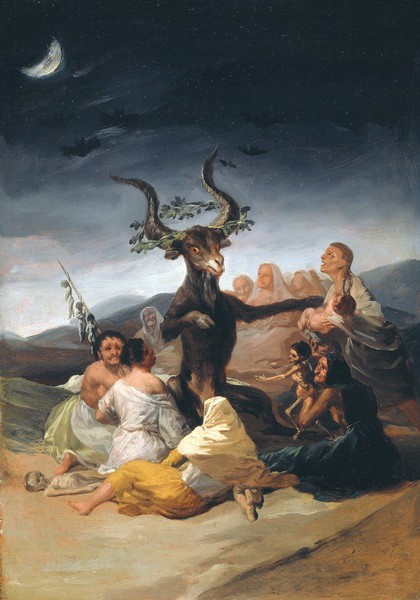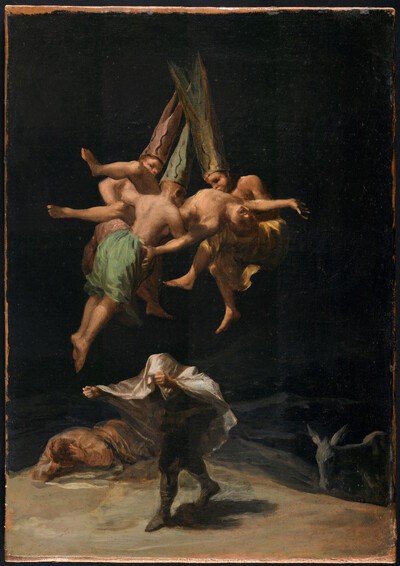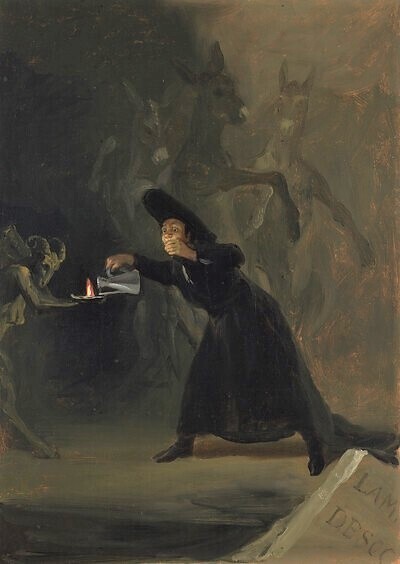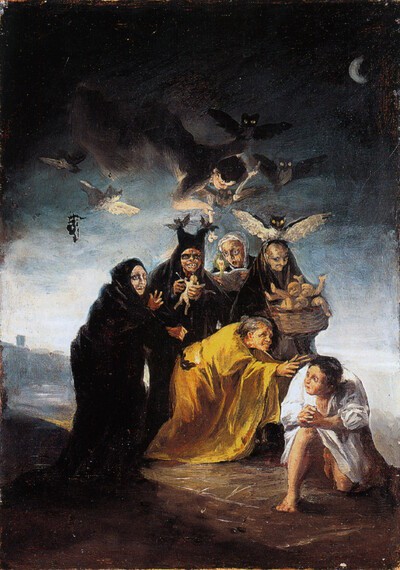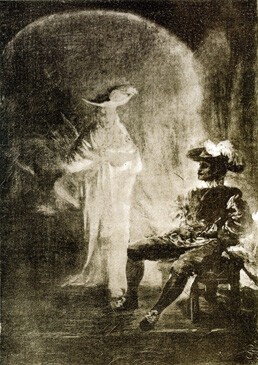- Cronología
- 1797 - 1798
- Ubicación
- Lázaro Galdiano Museum, Madrid, Spain
- Dimensiones
- 43 x 30 cm
- Técnica y soporte
- Oil on canvas
- Reconocimiento de la autoría de Goya
- Undisputed work
- Titular
- Lázaro Galdiano Foundation
- Ficha: realización/revisión
- 09 May 2010 / 15 Jun 2023
- Inventario
- (2.006)
- Otros títulos:
-
The Sabbath Witches
Goya was commissioned to paint this canvas to decorate the country house of the Duke and Duchess of Osuna. It later belonged to the Duke of Tovar, and was acquired by José Lázaro Galdiano in 1928.
In the centre of the scene, a demonic ritual is taking place by the light of the moon. The devil, in the form of a he-goat and wearing a crown of vine leaves, alluding to the iconography of Bacchus, presides over a circle of witches. One of the women is offering him a sacrifice of a new-born baby whilst an old hag presents him with a skeletal child. To one side of the he-goat, another woman has a pole slung over her shoulder, from which several human foetuses hang. Behind the main group, and picked out by a halo of light surrounding each of them, we see another group of female figures dressed in white tunics. Flying in the sky above them are several bats.
It is likely that Goya came across the subject for this painting in the text and humorous commentary which Leandro Fernández de Moratín wrote in 1812 about the auto-da-fé declared in Logroño in 1610. According to the inventory that was made of it in 1823, the Duke and Duchess of Osuna's library included a copy of Fernández de Moratín's text. It tells the story of two women who poisoned their children, after having been told to do so by the devil. Goya's painting also depicts the popular view held at the time that witches would often suck the blood of children, leaving them in such a weakened state that little could be done to save them.
This canvas, which openly criticizes superstition and ignorance, is related to a number of etchings sharing this same objective in the Caprices series: no. 47, A Gift for the Master and no. 60, Trials, in which human foetuses and the figure of the he-goat also appear.
The reclining female figure with her back to the viewer in the foreground of this painting, and under whose blanket another child is hiding, with only his legs visible, bears a strong resemblance to the drawing that appears on page 6r of Goya's Italian Sketchbook (Cuaderno italiano) (1771-1793, Prado Museum, Madrid). This drawing, a study in rendering drapery, depicts a completely covered figure and shows the influence of Salvator Rosa (Naples, 1615-Rome, 1673). Goya may have seen the work of this artist, who also regularly dealt with themes of magic and the supernatural, during his stay in Italy (1769-1771).
For more information, see The Witches' Flight.
-
Bosch, Goya et le fantastiqueVII Bordeaux Internacional ExhibitionBurdeos1957consultant editor Gilberte Martin-Méry. From May 20th to July 31st 1957cat. 67
-
cat. 52
-
Goya and his timesThe Royal Academy of ArtsLondon1963cat. 66cat. 79
-
GoyaKoninklijk Kabinet van Schilderijen MauritshuisThe Hauge1970organized by Ministerio de Estado y Asuntos Culturales and Réunion des Musées Nationaux, July 4th to September 13th 1970. Exhibited also at the Musée de l’Orangerie des Tuileries, Paris, October 25th to December 7th 1970, consultant editors Jeannine Baticle and A. B. de Vriescat. 27
-
Goya y el espíritu de la IlustraciónMuseo Nacional del PradoMadrid1988from October 6th to December 18th 1988. Exhibited also at Museum of Fine Arts, Boston, January 18th to March 26th 1989; The Metropolitan Museum of Art, Nueva York, May 9th to July 16th 1989, Madrid curator Manuela B. Mena Marqués, scientific directors Alfonso E. Pérez Sánchez and Eleanor A. Sayrecat. 26
-
Goya. El Capricho y la Invención. Cuadros de gabinete, bocetos y miniaturasMuseo Nacional del PradoMadrid1993from November 18th 1993 to February 15th 1994. Exhibited also at the Royal Academy of Arts, London, March 18th to June 12th 1994 and The Art Institute of Chicago, Chicago, July 16th to October 16th 1994, consultant editors Manuela B. Mena Marqués and Juliet Wilson-Bareaucat. 46
-
Goya: Prophet der ModerneAlte NationalgalerieBerlin2005from July 13th to October 3th 2005. Exhibitied also at the Kunsthistorischemuseum, Vienna, October 18th 2005 to January 8th 2006, consultant editor Manuela B. Mena Marquéscat. 67
-
Goya: Order and disorderMuseum of Fine ArtsBoston2014cat. 160
-
GoyaBasle2021p. 151
-
L'œuvre peint de Goya. 4 volsParís1928-1950p. 208, cat. 170
-
Goya, Saturno y melancolía. Consideraciones sobre el arte de GoyaStockholmAlquimis & Wiksell1962pp. 160-164
-
Goya and his sittersNew YorkThe Hispanic Society of America1964p. 17, il. 32
-
Vie et ouvre de Francisco de GoyaParísOffice du livre1970p. 188, cat. 660
-
BarcelonaPolígrafa1970vol. I, p. 295, cat. 356
-
L’opera pittorica completa di GoyaMilanRizzoli1974p. 110, cat. 339
-
Goya. El capricho y la invención. Cuadros de gabinete, bocetos y miniaturasMadridMuseo del Prado1993pp. 211, 212, 213, 214, 215 y 218 (il.),
-
Francisco de Goya, 4 vols.ZaragozaCaja de Ahorros de Zaragoza, Aragón y Rioja1980-1982vol. III, pp. 130 y 131
-
Goya en la Fundación Lázaro GaldianoMadridFundación Lázaro Galdiano1999pp. 84, 85 (il.), 86 y 87
-
Goya y sus seis asuntos de brujasGoyaMadrid2003pp. 197-214
